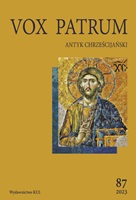Praca w monastycyzmie pachomiańskim
Work in Pachomian Monasticism
Author(s): Dariusz KasprzakSubject(s): Cultural history, History of Church(es), Social history, Ancient World, 6th to 12th Centuries, Sociology of Religion, History of Religion
Published by: Katolicki Uniwersytet Lubelski Jana Pawła II - Wydział Teologii
Keywords: pachomians; cenobitism; work; crisis; discernment;
Summary/Abstract: A patristic reflection on the key texts of Pachomian on the issue of cenobitic labor and its consequences allows us to draw the following conclusions. In pachomian’s ideological conception, work was to be an ascetic activity, carried out in silence and in complete submission to superiors. The primary type of Pachomian labor was agricultur-al work in the fields. Braiding, on the other hand, appears to have been a more ascetic complement to the former. The pachomian’s other work was subservient to agriculture and braiding. The Christological motivation for the work emerges from the letters of Pachomius and the Book of Horsiesi. The crises of the Pachomian communities of the late 40s and 60s of the 4th century verified the original assumptions of the Rule. The ca-suistic and bureaucratic normative management of the order during Horsiesi’s first term of office killed both the idealism of the monks and their human or monastic responsibility. It provoked opposition (“We want nothing to do with Horsiesi or the rules he sets”) and rebellion from the brothers. Under Theodore, another διακριτικός of the community, there was a calming down in the order. Paradoxically, systematic work brought tangible mate-rial results, which began to threaten the spiritual purpose of the order. This second crisis of the order’s management was resolved by entrusting to Divine Providence the tension between monastic observation and systematic work and the enrichment of the institution. Successfully, it seems, because the Pachomians survived in Egypt until the Arab invasion in the 9th century.
Journal: Vox Patrum
- Issue Year: 2023
- Issue No: 87
- Page Range: 155-174
- Page Count: 20
- Language: Polish

